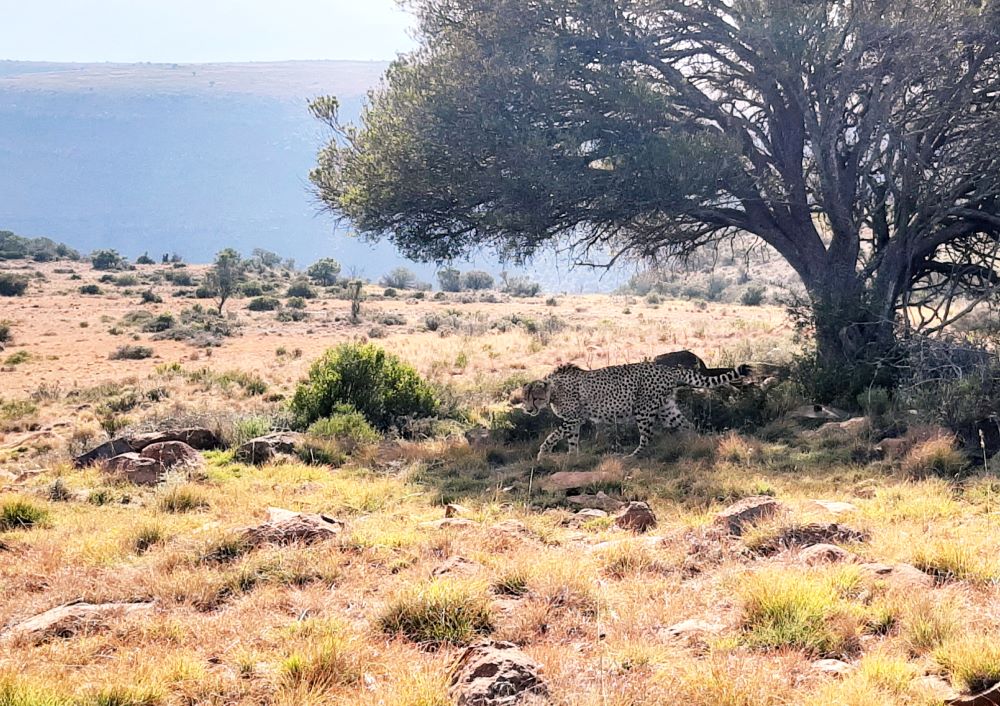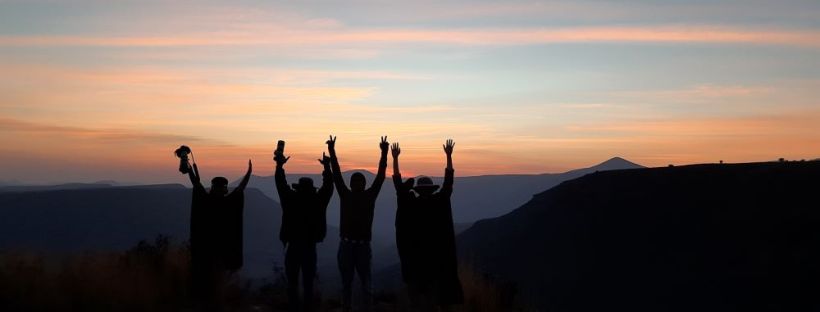With a landscape as flat and desolate as this, the wind and the silence comes from everywhere, all around you. The horizon of flat Great Karoo is interrupted only by large, canyon-like mountains that rise like exponential chart lines in the distance. In the middle of May, the almost-winter wind is unforgiving when you’re trying to keep your car on the road – a narrow tar strip that carries on in a straight perspective line about 20 km ahead.
They don’t call it the Valley of Desolation for nothing.

Driving to Graaff-Reinet at the foot of the Sneeuberg mountain range, one cannot help but wonder if you’re even still in the same country (especially if you’re coming from the Western Cape, which basically consists of green fields, mountains and the ocean). Nevertheless, our Africa Media group drove through the flat valley to the mountains and arrived safely at Mount Camdeboo Private Game Reserve, one of several adjoining reserves situated in the centre of this beautiful region. It was our first visit of the year – our wildlife media programs start running in May – and it’s a place that we love to return to with our students as much as we possibly can.

We arrived after dark, having watched the sunset from the Valley of Desolation lookout point in Camdeboo National Park, just outside Graaff-Reinet. Mount Camdeboo is still an hour and a long stretch of dirt road out of town, tranquilly isolated from human civilisation. They acquired a herd of six elephants recently – just a week ago, in fact – and we wondered whether the uprooted and broken trees around us could be a result of their getting used to their new home.
The reception building is right next to the majestic Manor House accommodation, where we would be staying for the next four nights. By now, you couldn’t see much outside, as darkness filled up the space between the trees and abundant stars overhead. Steve Turner-Smith, Camdeboo’s general manager and the one who welcomed us, informed us that the new elephants are, indeed, apparently in the area we just drove through. If it hadn’t been for the darkness, we would probably have seen them…

Mornings in the Karoo are cold. But we were willing to brave it with scarves and gloves on board the vehicle we lovingly dubbed the Safari Ferrari, in order to meet the rest of Camdeboo’s inhabitants: giraffe, oryx, black wildebeest, zebra, pale chanting goshawks, buffalo, blesbok, eland, warthogs and many, many baboons. They were all beautiful and welcoming.

The rhinos – a sensitive tale
The first rhino I saw on Mount Camdeboo was not a live one. And it shattered me.
Our field guide, Sean, stopped the vehicle on the plateau of Mt Camdeboo’s many mountains. He told us that we were now welcome to get out and walk to the carcasses of two rhinos under that nearby tree.
We quietly walked closer as he told their story. Poachers, who previously posed as guests, had cut through the fence in the middle of the night. I missed most of his tale, because I couldn’t believe what I was seeing. One hears or reads of such scenes, you say “That’s horrible” and then you move on with life, understandably. But this, actually seeing it – it’s something different entirely. It’s the truth, guttural and heartwrenching. And you can’t look away. One rhino was pregnant, a couple of days away from giving birth.
I started crying.
Rhinos die when their horns are removed hastily and forcefully, because cutting the horn too low means opening the cavities in the face – the creature essentially bleeds out while tranquilised, if they’re not shot dead from the start. The poaching syndicate responsible for this and many other instances on various game reserves, known as the Ndlovu gang, have recently been caught and sentenced to 25 years in prison. Mt Camdeboo’s owner, Iain Buchanan, had the unborn rhino fetus removed and cast in bronze, a sad and beautiful tangible remembrance. He also started an awareness campaign called Fragile, a massive project in the making.
On the rest of that first drive, I struggled to focus on anything other than what I just saw. But not even two minutes later, a few gorgeous living rhinos comforted me. They were snoozing, peacefully and safe.
***
We went on a second game drive after lunch, a longer one so the photographers could capture their first Camdeboo sunset. Sunsets here are a cascade of colours and clouds above the rise and fall of mountains and plains… but then, so are the sunrises.

One of the most memorable safari moments thus far is the moment I met Mount Camdeboo’s male cheetah, Madoda. We went searching for him one morning during our visit. It’s unnerving, let me tell you, to leave the safety of the safari vehicle behind to trek into the low bushes on foot in search of a cheetah. When we found him, I was immensely startled, amazed and confused – all at once – at how close we got to him. It must have been less than three meters. He was lying on his side, at ease, probably waiting for a herd of antelope to pass by. He looked like he was just chilling in the sun.

I had no words, no thoughts in my mind other than, “It’s a cheetah, and it’s right there,” even though it didn’t seem to bother anyone else. We stood there, just looking at him, for several minutes. Eventually, when we tried to get too close for photos, he got up and gracefully disappeared into some bushes.
The patch of grass he was lying on was still warm. He must have laid there for a while, as the grass was bent to the shape of his body in a cosy-looking bed.

Madoda is one of two cheetahs on the reserve. The other one is named Thandi, though we didn’t get to see her during our four-day stay. What we did see (well, sort of) was the brand new elephant herd. When I say ‘new’, I mean they arrived just a week before. They were a family of six and they were still getting used to their new home. Penny, the elephant expert at Camdeboo (also known as The Elephant Lady) took us with her on her daily drive to observe and monitor their behaviour, and we were eager to join. In the end, it took us about four hours and a long drive up to the top of the mountain before we got a peek at them in the kloof below us. They looked like slowly moving rocks – but we saw them!

My first week of experiencing Mt. Camdeboo was a soulful one. The place took my breath away. It left me entirely worriless, contemplating whether anything outside this beautiful bowl of mountains was even worth returning to. Every element of the place – its animals, its landscape, its wonderful people – can teach you something new. I look forward to visiting again – it would be like coming home.




Seeing your first rhino carcass is always traumatic, and it doesn’t get any better.
Love the story ☺️
LikeLiked by 1 person